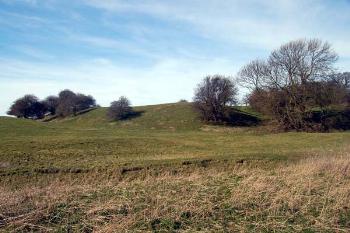Cainhoe in General

Cainhoe Castle
Landscape
Cainhoe lies south of the village of Clophill and much of it is low lying, the motte of the castle standing about 180 feet above sea level. Cainhoe Manor is higher at around 255 feet.
The underlying, or solid, geology is a sandstone known as Woburn Sands Formation. It was laid down between 99 and 121 million years ago during the Cretaceous Period in warm, shallow seas. A band of head, a mixture of sand, gravel, silt and clay runs as a top soil north to south and in the area of the junction between the A507 and Clophill Road the superficial geology is a type of diamicton known as Lowestoft Formation.
Name
Cainhoe is first mentioned in Domesday Book of 1086 as Chainehou or Cainou. The name means "the spur of land belonging to Cæga". Over time the following forms have been recorded:
- Cahenno: c. 1115;
- Kainho: 1227;
- Cainho: 1227;
- Caynho: 1227;
- Keinho: 1235-1311;
- Keynho: 1235-1311;
- Cayno: 1272-1428;
- Kayno: 1272-1428;
- Kayho: 1272-1287;
- Cayho: 1272-1287;
- Keynoo: 1512;
- Keynho: late 16th century.
Administrative History
Cainhoe is usually regarded as part of the parish of Clophill, but it is not quite so simple as that. Other than the impressive earthworks of the castle, Cainhoe today is little more than a scatter of farms and it seems as though this was probably always the case. The Domesday Book recorded eleven heads of household, who would have been men so it is probably necessary to multiply this figure by at least four to account for their dependents, even so this gives a total population of around fifty. This, together with the presence of a mill in Cainhoe, and none in Clophill, might just possibly suggest that during the Middle Ages Clophill lay on the ridge to the north, around the old church and that the flatter ground now occupied by part of the modern village, perhaps that around and south of the High Street, was then considered part of Cainhoe.
It seems as though the area round the castle was known as Great or Upper Cainhoe by the 13th century with Little Cainhoe being in the parish of Flitton parish near the boundary with Silsoe [L323 and L332]. Today part of Cainhoe, around Cainhoe Manor and Cainhoe Park Farm lies in the civil parish of Gravenhurst and the ancient parish of Upper Gravenhurst.